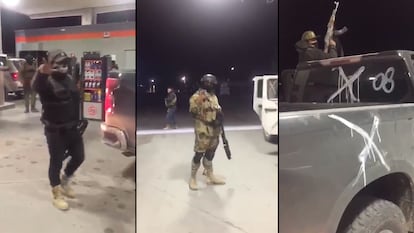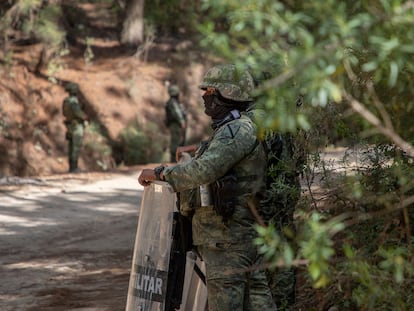Mexican military absent as El Chapo’s sons sow terror
The city of Caborca in Mexico’s Sonora state was held hostage for 24 hours by dozens of hitmen loyal to the sons of drug lord, sowing terror on its streets and killing two people
It all began with the warning from truck drivers. Urgent messages sent out the alert last Tuesday afternoon that a tragedy was unfolding, as dozens of pickup trucks covered in homemade armor and mounted with assault rifles were seen moving fast northwards to Caborca, the final city in the Sonora desert before reaching the United States.
The guns were of a caliber capable of taking out helicopters, and the vehicles were marked with an X so as not to confuse them with the enemy. The truck drivers’ warnings increased in urgency, but the men dressed in military and tactical gear took time to fill their cars with gas and film themselves boasting about their artillery: “The Chapiza [El Chapo’s men] is here: we are coming with everything,” one said.
The ruthless sons of the world’s biggest drug trafficker, Joaquín “El Chapo” Guzmán, were about to lay siege to an entire town. The national news did not cover the incident unfolding, overtaken by a spat between supporters of President Andrés Manuel López Obrador and his adversaries over a media investigation into his eldest son. Residents of wealthy areas of the capital were protesting online about soaring rent prices, and meanwhile, a war had just been unleashed in the north, but is also ongoing in Michoacán, Colima, Guerrero and Zacatecas. Thousands of people were praying in their homes that the bullets would not go rip through their walls. All of this happens in Mexico every day, simultaneously.
Around 7pm on Tuesday, the convoy of more than 20 pickup trucks thundered from Altar to Caborca, some 35 kilometers to the north. In Altar, El Chapo’s sons, known as Los Chapitos [Little Chapos], have become more bloodthirsty and unpredictable than their father was. In this remote town a few kilometers from the United States, the drug traffickers have found another very profitable business in recent years: migrants. This is the point of arrival of all who seek to move north. Hundreds of them every day try to cross to the United States for prices ranging from $4,500 to $7,500 per person.
In Caborca, the heirs of the old capo of the 1990s, Rafael Caro Quintero, maintain power. Grouped under his lieutenant, known as “El Cara de Cochi,” they all hail from Sinaloa state and have controlled the drug trafficking routes through the desert to the United States for decades. Now that El Chapo is serving a life sentence in the United States and Caro is a fugitive, the powerful Sinaloa cartel has fragmented. The younger Chapos want the whole business: the drug routes, the weapons and the migrants, according to veteran reporters in the area, so they will threaten and besiege the enemy city when they feel like it.
The gunshots were getting closer and closer. By 7pm on Tuesday evening, more information had arrived through Whatsapp groups of what the truckers had warned about. The police, the National Guard and even the armed forces also knew. People waited for the siege of their town to begin without any authority to prevent it. From their living rooms and bedrooms they listened to bullets without respite for hours: “Should we leave? Where to, to a hotel? Will they come for me?” one woman recalled thinking. “It’s like being in a war zone. We heard the first shots at midnight and the final ones at six in the morning on Wednesday. Nobody slept,” she added, preferring not to give her name for fear of reprisals.
No one in Caborca understands how a convoy of that size could pass in front of the National Guard, Federal Defense and municipal police buildings without a single member of the security forces showing up to defend the town. “There was not a single authority that went out to confront them, they all hid. They abandoned us,” said the woman. These same men, more than 100 of them, also took over the city in March last year.
This was a declaration of intent, and a show of force that began with the takeover of the city. Shots rang out against the façades of houses on the empty streets, leaving a string of bullet holes, and two men were shot and left dead in the street amid the search for possible enemies in houses. “A neighbor told me how the gunmen were leaning out of the windows, on the rooftops, with their weapons, as if they were looking for people, possibly drug dealers, with all the impunity in the world”, added the woman.
One of the pickup trucks knocked down the electric gate of the Uribe household at 3am. When Eduardo Uribe’s mother woke up, a group of 10 hitmen had surrounded her bed, and were looking for her son. He was sleeping in another room with his friend, Sebastián Manríquez, the son of a veteran Caborca journalist. They took them away, despite the pleas of the desperate mother, and were put into two different vans. At 8pm the next night, Manríquez reappeared. His friend was found alive on Thursday. Three others were kidnapped that night, and two are still missing.
Caborca is still wounded from the experience. Schools have closed, and mayor Abraham David Mier Nogales has recommended an unofficial 10pm curfew for businesses. “I recognize that the events experienced […] exceeded the level of response of the police, as we were not able to prevent these unfortunate events,” he acknowledged. “It’s as if they were giving the hitmen a chance, a vacation, while they pretend to be in control,” responded an indignant resident.
Just six days ago, President López Obrador embarked on a tour of Sonora, which is governed by his former security chief Alfonso Durazo. The tour included a review of building works on baseball stadiums and meetings with authorities of the Yécora, Seri and Yaqui peoples. The federal government’s strategy is to increase the presence of soldiers and National Guard agents. But the raw numbers of uniformed officers have not prevented shootings, not in Sonora nor in Michoacán or Zacatecas, another of the states with a larger presence of organized crime over the last year.
Sonora state, with almost three million inhabitants, has a homicide rate of around five people a day. In 2021, 1,968 people were killed, a figure that has not stopped rising and that broke a record of 23% more deaths than the previous year. Durazo made the issue of insecurity his main campaign issue in elections last year, and even boasted about the seven National Guard barracks built in the state, as well as the deployment of almost 3,000 members of a controversial military corps created specifically to control violence in the country.
The narco criminals abandoned Caborca after 24 hours, numbering at least a hundred men with heavy weapons who posted images on social media as they took the streets without any authority to stop them. Hidden in their homes, citizens were cornered by the real power that governs Mexico. The campaign promises, and the pomposity of the soldiers and their new barracks have been silenced by the force of bullets.
Tu suscripción se está usando en otro dispositivo
¿Quieres añadir otro usuario a tu suscripción?
Si continúas leyendo en este dispositivo, no se podrá leer en el otro.
FlechaTu suscripción se está usando en otro dispositivo y solo puedes acceder a EL PAÍS desde un dispositivo a la vez.
Si quieres compartir tu cuenta, cambia tu suscripción a la modalidad Premium, así podrás añadir otro usuario. Cada uno accederá con su propia cuenta de email, lo que os permitirá personalizar vuestra experiencia en EL PAÍS.
¿Tienes una suscripción de empresa? Accede aquí para contratar más cuentas.
En el caso de no saber quién está usando tu cuenta, te recomendamos cambiar tu contraseña aquí.
Si decides continuar compartiendo tu cuenta, este mensaje se mostrará en tu dispositivo y en el de la otra persona que está usando tu cuenta de forma indefinida, afectando a tu experiencia de lectura. Puedes consultar aquí los términos y condiciones de la suscripción digital.
More information
Últimas noticias
Most viewed
- Reinhard Genzel, Nobel laureate in physics: ‘One-minute videos will never give you the truth’
- Pablo Escobar’s hippos: A serious environmental problem, 40 years on
- Charles Dubouloz, mountaineering star, retires at 36 with a farewell tour inspired by Walter Bonatti
- Why we lost the habit of sleeping in two segments and how that changed our sense of time
- The fall of a prolific science journal exposes the billion-dollar profits of scientific publishing












































